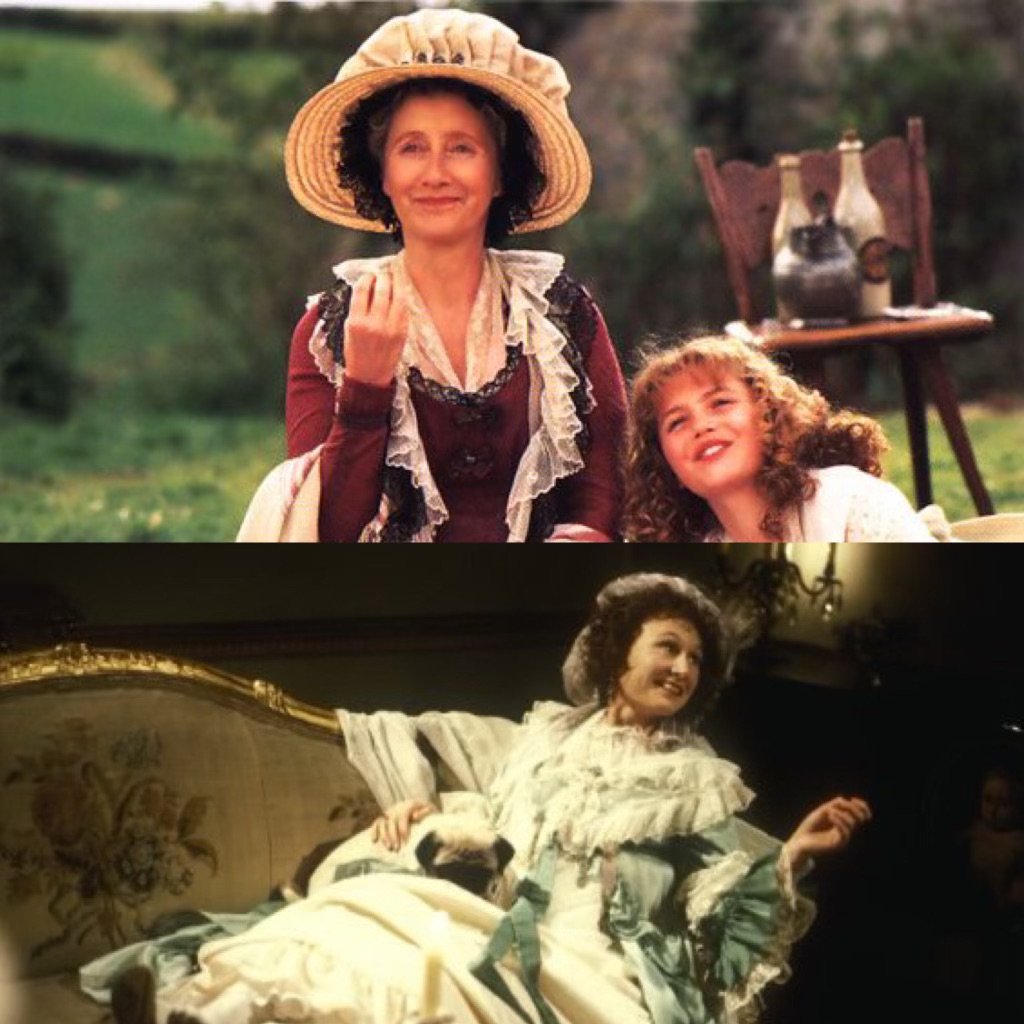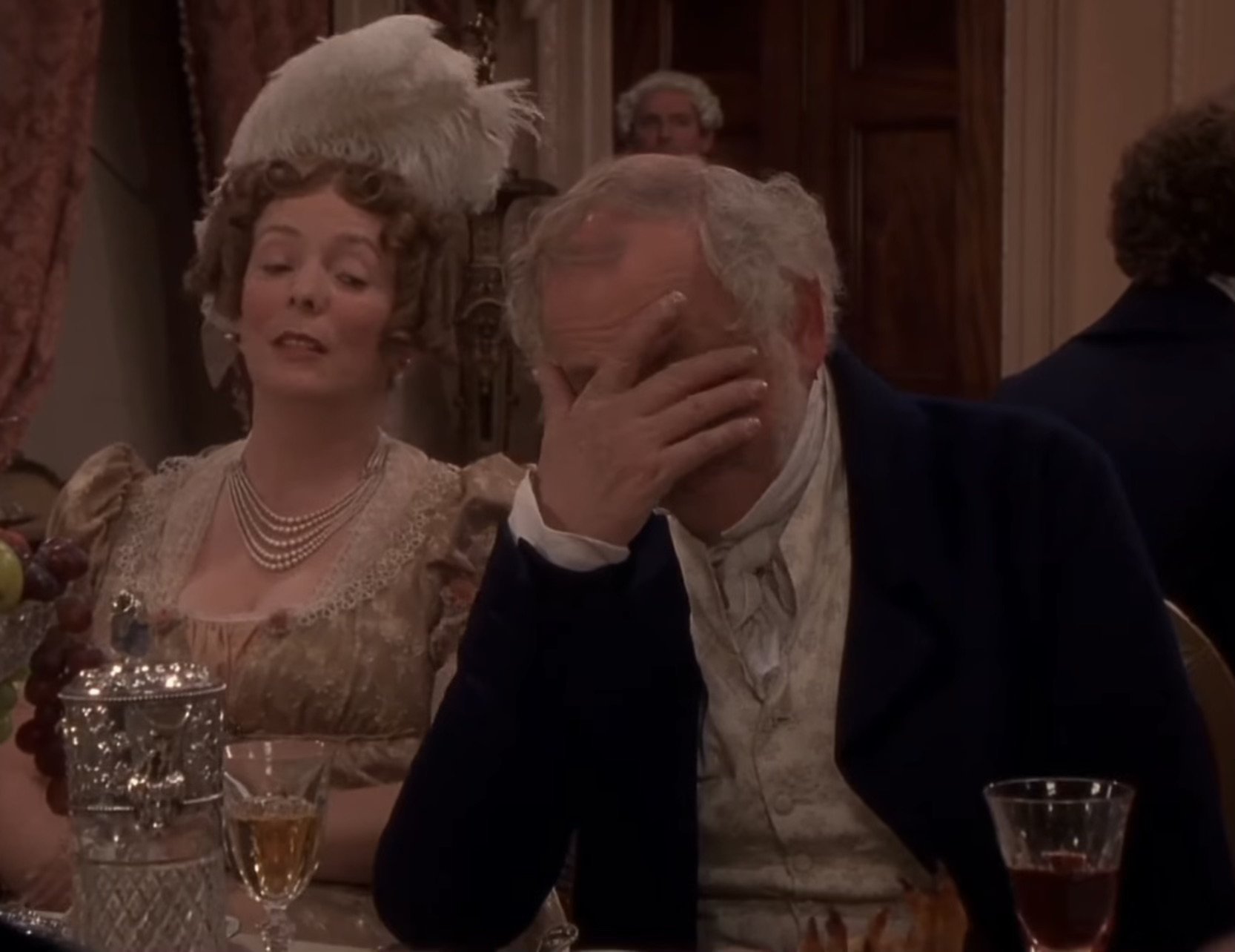“HAPPY FOR ALL HER MATERNAL FEELINGS WAS THE DAY ON WHICH MRS. BENNET GOT RID OF HER TWO MOST DESERVING DAUGHTERS”—PRIDE AND PREJUDICE
Author Amy D’Orazio explores the sympathetic side to mothers in Jane Austen’s novels.
There are parental figures of all sorts within the Jane Austen fan community. I imagine that among us are mothers, fathers, stepparents, grandparents, foster parents, adoptive parents, fur parents… and so on! But while many of us know the joy of raising a child, Jane Austen was never a mother.
Mrs. Dashwood (top) Sense and Sensibility, 1995 and Lady Bertram (bottom) Mansfield Park, 1993
However, although she never became a mother, she made up for it by being a devoted and interested aunt to thirty nieces and nephews. She adored being an aunt. To a young niece, who had just become an aunt herself, she wrote, in 1815, “Now that you are become an Aunt, you are a person of some consequence & must excite great Interest whatever You do. I have always maintained the importance of Aunts as much as possible, & I am sure of your doing the same now.—Believe me my dear Sister-Aunt.”
Likewise, it seems her young nieces and nephews admired her. In her diary in 1817, shortly after Austen’s death, Fanny Austen-Knight wrote, "I had the misery of losing my dear Aunt Jane after a lingering illness." One could guess that Fanny might have seen her aunt as a maternal figure and friend; Austen would have been eighteen when Fanny was born, and Fanny was twenty-four when her dear aunt died.
So how, I wondered, did her feelings about being an aunt and not being a mother influence her writing?
In looking at the role of mothers in Austen's books, you might initially think that our dear authoress had a dim view of mothers. Most of the mothers in Austen's novels fall into one of three categories: silly but affectionate (Mrs. Bennet, Mrs. Dashwood); overbearing or unpleasant (Lady Catherine de Bourgh, Lady Russell); and dead (Lady Anne Darcy, Lady Elliott, Mrs. Woodhouse, and more!) In fact, in searching through the novels, I found that most of the 'good' mothers were not the mothers of the main characters; some were not mothers at all.
Lady Catherine de Bourgh, Pride and Prejudice, 1995
Mrs. Gardiner, for example, is the beloved aunt in Pride & Prejudice, serving as a model of femininity to the Bennet sisters and providing sound advice and timely trips to Pemberley. In my opinion, she was probably not old enough to be an actual mother figure to the Bennet ladies. With four children under the age of ten around her feet, Mrs. Gardiner was likely only about thirty, closer in age to Elizabeth and Jane Bennet than she was to their parents. Miss Taylor/Mrs. Weston is another warmly regarded "mother" to Emma Woodhouse. Unlike Mrs. Gardiner, she did raise Emma, having been her governess from early childhood.
So, the immediate conclusion might be that Austen had an overall negative impression of motherhood. It is important to remember, however, that the novels are written from the perspectives (mostly) of twenty-something young people; how Austen wrote about mothers, therefore, might be more reflective of their opinions rather than her own. Examining the mothers in Austen's novels through the eyes of a mother yields a different impression. Mrs. Bennet is one such example.
Mrs. Bennet and her daughters in Pride and Prejudice, 2005
On the surface, Mrs. Bennet is presented (through the eyes of her daughter and Mr. Darcy) as vulgar, silly, uninformed, and ridiculous. However, between her and her husband, it is Mrs. Bennet who truly understood the precariousness of their situation. Life in the Regency Era was lived close alongside death, and losing Mr. Bennet would have been calamitous. Therefore, her cries of 'what will become of us?' were not histrionic but rather valid concerns!
As those interested in the Regency Era know very well, a gently bred woman needed to marry for security. Alas, the pool of available gentlemen was small, and the Bennet ladies lacked fortune and education. Further, they lived in a small town where they were undoubtedly well-acquainted with any and all eligible men. The fact that Jane Bennet was not engaged or married at the age of 22 suggests that the pickings were slim.
Were Mr. Bennet concerned for his girls' futures, he might have done several things: invest Mrs. Bennet’s £4000, see to their educations, or take them to London (or Bath, or Brighton) to meet potential husbands. However, he did none of that.
Mr. and Mrs. Bennet, Pride and Prejudice, 1995
It was up to Mrs. Bennet, who—having raised her own station—took matters in hand and did all she could to secure husbands for them through whatever means she had at her disposal. The day she saw two of her girls married—in addition to Mrs. Wickham—was the realization of all her most optimistic plans and schemes for her daughters.
Even looking at the overbearing group of mothers yields a slightly different picture when seen through maternal eyes. One such example is Lady Catherine de Bourgh and her relationship with her daughter, Anne de Bourgh, the heiress of Rosings Park and the supposed intended bride for Mr. Darcy.
Although her malady is never explicitly stated, Anne de Bourgh has a number of hallmarks of a person with a chronic illness, likely since childhood as it affected her education and prevented her from going to London to be presented. She is startlingly thin and pale and appears sickly and cross to Elizabeth Bennet’s eyes.
Austen had, herself, a lifelong history of prolonged and unusually complicated health issues, beginning with typhus at a young age and proceeding to the illness which prematurely took her life. In her later years, Austen suffered rheumatism which I have always believed was Anne de Bourgh’s illness as well—she is certainly described by Austen as someone with that disease. The chronic fatigue and pain associated with rheumatism would certainly make anyone ‘sickly and cross!’
Anne de Bourgh, Pride and Prejudice, 2005
Given the evidence that Anne had a chronic and incurable disease, it makes Lady Catherine's concerns—her overbearing and even meddlesome bearing—more understandable. She was a single parent with a chronically ill child. I imagine many mothers in that scenario might behave in ways perceived as ‘officious!’ Even her urgency to see her daughter married to Mr. Darcy might be seen more benevolently—after all, like Mrs. Bennet, she merely wished to see her daughter cared for. Who, but a family member, would she be able to trust?
It is clear to me that Austen did find great pleasure in being an aunt to her many nieces and nephews, and that satisfaction is illustrated in the relationships of her characters like Elizabeth Bennet and her fondness for her aunt Gardiner in Pride & Prejudice, to name but one example from Austen’s books. Nevertheless, re-evaluating the mothers that Austen wrote in her novels from the perspective of a mother can result in a deeper understanding of those characters. I have used Mrs. Bennet and Lady Catherine de Bourgh as my examples—giving both a more benevolent hue, or so I hope!—but there are many others to reconsider likewise. Lady Russell in Persuasion for example might be less meddlesome than someone with a legitimate concern for her dear friend’s daughter who was about to throw her life away on a man who was beneath her. Mrs. Dashwood might be considered less a silly creature than a woman who was trying to keep her spirits up after the loss of a husband and home.
As I am sure many of us do, I love to re-read Austen's novels, some over and over and others just once or twice. In particular, take a second look at Mrs. Bennet with the eye of a mother—I'd wager you'll find her much different from how she's often painted!
©️Amy D’Orazio 2022. Amy D’Orazio is a longtime devotee of Jane Austen and fiction related to her characters. She began writing her own little stories to amuse herself during hours spent at sports practices and the like and soon discovered a passion for it. By far, however, the thing she loves most is the connections she has made with other fans of Jane Austen and her work.
Amy currently lives in South Carolina with her husband and daughters, as well as three Jack Russell terriers who often make appearances (in a human form) in her books.
Works Cited:
Letter To Caroline Austen, Mon, 30 October 1815, at Chawton. From Jane Austen’s Letters To Her Cassandra And Others.. Chapman, RW 1952
Personal diary, Fanny Austen-Knight 22 July 1817, Austen-Leigh, Richard Arthur, 1872-1961 Jane Austen, Her Life and Letters: A Family Record by Austen-Leigh and Austen-Leigh
Austen, Jane. Pride and Prejudice, 1813
Upfal, A. Jane Austen’s lifelong health problems and final illness: New evidence points to a fatal Hodgkin’s disease and excludes the widely accepted Addison’s. Medical Humanities 2005;31:3-11
Sanders, M. and Graham, E. ’Black and white and every wrong colour’: The medical history of Jane Austen and the possibility of systemic lupus erythematosus. Lupus 2021 Apr;30(4):549-553.
Le Faye, D. A Chronology of Jane Austen and Her Family: 1700-2000
Letters. Jane Austen to Fanny Knight, 20 February 1817 and 25 March, 1817. Chapman RW. Jane Austen’s letters to her sister Cassandra and others 1796 – 1817. London: Oxford University Press, 1954.
The Jane Austen Literacy Foundation now offers a range of literacy resources for teachers and schools, including a 30 Day Literacy Challenge, Writing Competition, Bookplates and inspiration.








